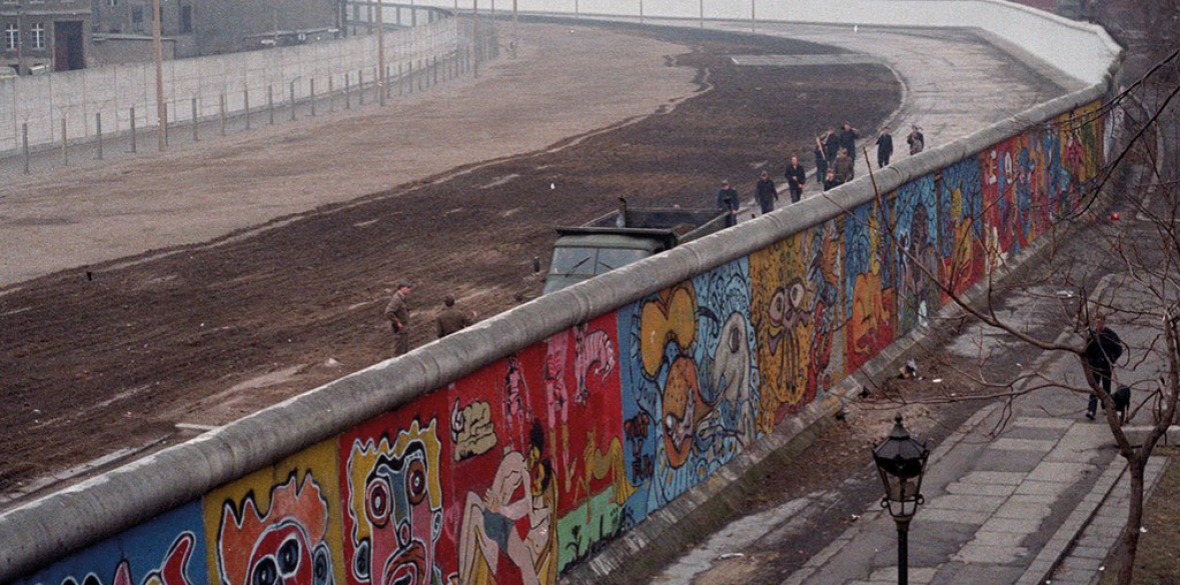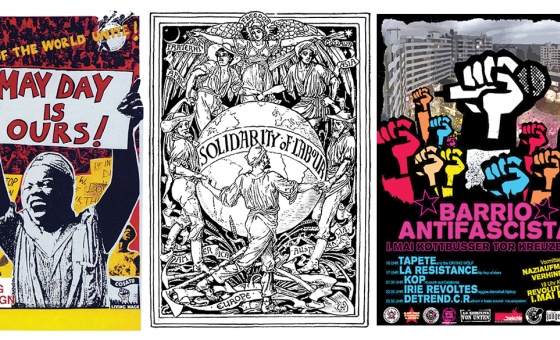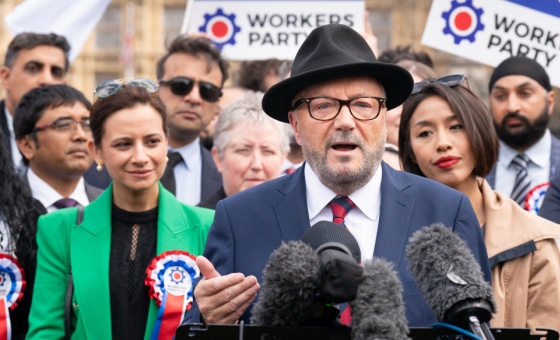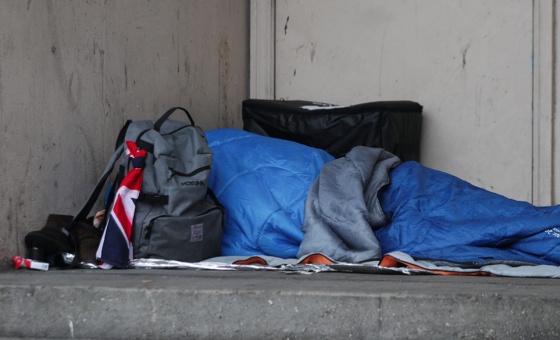This is the last article you can read this month
You can read more article this month
You can read more articles this month
Sorry your limit is up for this month
Reset on:
Please help support the Morning Star by subscribing here
THOSE who travel here to Berlin will no doubt not only spot the incredible — or on occasion pretty awful — street art around the city, but also visit at least one of the three surviving sections of the Berlin Wall, the structure that politically divided the city for 28 years between 1961 and 1989.
For some, a visit to the wall is accompanied by a tour of what’s known as the Berlin Wall Museum, right next to Checkpoint Charlie.
If one were to visit this museum, you would emerge from it not necessarily knowing a great deal about the complexities of what led to the building of the wall.
You would be told that effectively because the Soviet Union was an evil, repressive empire that hated freedom, it decided to wall in the East German population.
It’s useful to understand that when Germany was divided in 1949 it was the US, France and Britain that tore up the Potsdam Agreement that had been agreed four years earlier.
The agreement held that Germany must remain a single, united country. By creating the Federal Republic of Germany, or West Germany, the agreement was made effectively void.
It was in the aftermath of this decision that the Soviets created a rival state — the German Democratic Republic, or East Germany — in its occupation zone.
The creation of West Germany coincided with the creation of the North Atlantic Treaty Organisation (Nato). Effectively, one could say that this organisation’s main purpose was the protection of the interests of Western capital, now under threat from the expansion of the socialist system into eastern Europe.
The biggest problem with the creation of the two Germanys was not necessarily the fact that neither recognised the other, but that Berlin — which had been split into four allied zones of occupation after the war — now sat 100 miles inside of East Germany.
This meant that the US, France and Britain retained control of West Berlin deep inside of a country that they refused to recognise — and wanted to remove from the map altogether.
In 1952, Soviet leader Joseph Stalin sent a series of messages that collectively became known as “Stalin’s note” to the United States, urging the West to consider the prospect of a neutral Germany.
According the Soviets, they were willing to relinquish control of East Germany if there could be an agreement on neutrality for the country.
By November 1958, the Soviet Union gave the US an ultimatum to leave West Berlin, this coming in the aftermath of the US stationing nuclear weapons in West Germany.
Nikita Khrushchev gave the Western powers six months to leave in order to create a demilitarised city that would serve as the capital of East Germany.
Alas, because of the cold war — and because of the leverage the US saw West Berlin as providing for them deep inside Soviet territory — this ultimatum was ignored.
By August 1961, around 3.5 million East Germans had left the country, which totalled roughly 20 per cent of its entire population.
This profound brain drain was encouraged by the US, which invested handsomely in the reconstruction of West Germany and its industry, including those who made fine profits from working with the Nazi dictatorship.
The US goal was ultimately to make West Germany a bastion of an “economic miracle” that sharply contrasted with the largely agrarian East.
Many who come to Berlin to see the wall never actually leave knowing the official name given to it by the GDR, which was the Anti-Fascist Protection Wall.
Some would scoff at the notion that the supposed model of post-fascist democracy in the Federal Republic of Germany could be considered anything resembling a continuation of Hitler’s regime.
There were, however, many key figures from the Nazi era that were given key posts in West Germany, including scores of generals.
Perhaps most notably, Reinhard Gehlen, a lieutenant-general who helped plan the attack on the Soviet Union, was elevated by the US to the head of West German intelligence.
The West German government also took the decision to ban the Communist Party of Germany (KPD) in 1956, a decision that smacked of the Nazi regime’s early decision in 1933 to ban the same party when it set up concentration camps for its leaders and thousands of its members.
It is impossible to have an honest conversation about the Berlin Wall and the reasons for its construction without access to all of the historic information that led to the partitioning of Berlin and Germany.
Understanding the role of the US, Britain and France — and Nato — in wanting to strangle socialism in the east, makes the construction of the wall appear significantly more defensive than the modern rulers of Germany would have you believe.
All of this should make us understand how important it is that with Nato waging a proxy war against Russia today, we reflect on the root causes of this military conflagration that is costing Ukrainians and Russians so dearly.
With the fall of the wall in 1989 and German reunification less than a year later, Nato should have seen its dissolution.
But alas, even with the collapse of the Soviet Union in 1991, it continued on. From this point forward, the US was not so concerned with fighting socialism, as most of those countries had experienced counter-revolutions that restored capitalism.
It was, however, concerned with trying to take out any states that still held independent orientations, such as nationalist regimes in Iraq, Libya, Syria, and Iran.
As the 1990s closed, it appeared as if Russia was firmly in the grip of the West, economically and politically relegated to the status of a neocolony.
Then came Vladimir Putin. It mattered little to the US that he was a far cry from another Vladimir who had overthrown the relations of capitalism in 1917. What mattered is that he asserted Russia’s right to its own independent course.
Putin’s Russia has been a thorn in the side of the US because it is ultimately a government that refuses to play by what the West considers to be the only acceptable playbook.
Ultimately, this independent position and the desire for multipolarity in place of a unipolar world has put Russia in the crosshairs. Why did the United States invest $5 billion in the overthrow of the Ukrainian government of Viktor Yanukovych in 2014?
Was it really about Ukraine, or was it about being able to step more firmly onto Russia’s doorstep?
Ukraine being thrown into the arms of the West has ultimately meant the Berlin Wall has been pushed significantly east — almost up to Moscow itself.
Should we not mention the fact that as the wall had fallen in 1989, verbal reassurances were given to the Soviet Union that Nato would not expand east a single inch past the Elbe River?
What about the browns, the actual fascists? In order to not appear to be “Putin lovers,” should we simply not mention the existence of neonazi forces organised within the Ukrainian state structures?
Should we pretend that the “defenders of Mariupol” were simply Ukrainian patriots and not neonazis of the Azov Battalion who glorify and follow in the history of Nazi collaborators like Stepan Bandera?
Should we turn a blind eye to the fact that just like Hitler did in 1933, one of the first acts of the post-coup Ukrainian state in 2014 was to ban the Communist Party of Ukraine that had a membership of at least 100,000?
None of this being written to convince anyone that Russia’s intervention into Ukraine is justified. It is, however, to say that you can’t have an honest conversation about it if you think the conflict began with the invasion, or if you reduce the narrative to one of an evil dictator deciding he wants to crush all of Europe.
Just as in the 1950s, the issue of neutrality — then in Germany and now in Ukraine — has been scoffed at by Nato when brought up.
To those who strive for peace, and who know the history of Ukraine as the country where a power struggle is playing out between the United States and Russia, will know that the solution doesn’t lie in anything other than negotiations.
This is in contrast to the solution for the arms manufacturers — such as Germany’s Rheinmetall — in flooding Ukraine with weapons and prolonging the fighting as long as humanly possible, down to the last Ukrainian soldier.











